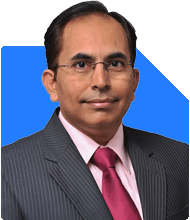Ramalingam Kalirajan |10870 Answers |Ask -Follow
Mutual Funds, Financial Planning Expert - Answered on Jun 20, 2025
He has an MBA in finance from the University of Madras and is a certified financial planner.
He is the director and chief financial planner at Holistic Investment, a Chennai-based firm that offers financial planning and wealth management advice.... more
.jpg)
I have the following mutual fund SIP 1. Mirae asset large & mid cap - 2000 pm 2. Axis large cap - 2000 pm 3. SBI small cap - 500 pm 4. Axis ELSS tax saver - 500 pm 5. Parag parikh flexi cap - 2000 pm I want to maximize profit and diversify further. Please review my portfolio and suggest for modification Pls suggest
Mirae Asset Large & Mid Cap – Rs.?2,000/month
Axis Large Cap – Rs.?2,000/month
SBI Small Cap – Rs.?500/month
Axis ELSS (tax saver) – Rs.?500/month
Parag Parikh Flexi Cap – Rs.?2,000/month
You are disciplined and focused on long?term growth.
Now let us analyse and suggest improvements with clarity and purpose.
Understanding the Strengths of Your Portfolio
Core Large?and?Mid?Cap Funds (Mirae + Axis):
Provides solid equity exposure in mid/large segments.
Good backbone for long?term wealth creation.
Risk?return balance is reasonable in these segments.
Flexi-Cap Fund:
Offers flexibility to adjust equity allocation across caps.
Broad market coverage supports multi-cap exposure.
Helps in tactical allocation across large, mid and small caps.
Small?Cap Fund:
Adds high-growth potential segment to your mix.
Small allocation ensures controlled exposure.
Enhances return potential over long horizon.
ELSS (Tax Saver) Fund:
Provides tax benefit under Section 80C.
Lock-in of 3 years is short compared to other tax-saving plans.
Offers equity exposure with tax efficiency.
Identifying Overlaps and Risks
Large?Cap Overlap: Mirae, Axis, and Flexi cap may hold similar core stocks.
High Equity Bias: Entire Rs.?7,000 monthly in equity funds.
Concentration Risk: Heavy tilt toward equity without stability cushion.
Volatility Risk: Small cap exposure can cause portfolio swings.
Taxation Awareness: Equity funds attract LTCG/STCG rules; plan withdrawal wisely.
Goals for Portfolio Enhancement
Better diversification across asset classes.
Smoother risk?return profile.
Enhanced inflation?beating potential.
Tax efficiency and withdrawal planning.
Flexibility to adjust as per market and life changes.
1. Introduce Hybrid Balanced Fund
Why Add Hybrid Fund?
Gives a cushion during market corrections.
Reduces overall volatility vs pure equity.
Provides regular debt exposure within equity portfolio.
Suggested Move:
Allocate Rs.?2,000/month to an actively managed hybrid balanced fund.
Use regular plan for guided asset rebalancing.
Keep it ~10–15% of total monthly investments.
2. Consider Mid?Cap Allocation
You already have some mid?cap exposure through the flexi?cap fund.
But a dedicated mid?cap fund adds controlled focus.
Benefits of Mid?Cap Funds:
Offers higher returns than large caps over long haul.
Suits 7–10 year horizon when you want growth.
Adds exposure to tomorrow’s large?cap companies.
Suggested Allocation:
Allocate Rs.?1,000–2,000/month to a reliable mid?cap equity fund.
Keep total mid?cap equity exposure under 20% of equity portfolio.
3. Reduce Redundancy in Large?Cap Exposure
Three funds cover large?cap space heavily.
Consider consolidation:
You can choose one long?term large?cap fund.
Keep it as the large?cap anchor.
Use the other equity funds to diversify across market caps.
Suggested Approach:
Continue either Mirae large & mid or Axis large?cap fund.
Redirect some of the other fund's amount (e.g., Axis ELSS if large?cap heavy) to mid-cap or hybrid.
4. Increase Portion for Tax?Efficient ELSS
Your Rs.?500/month ELSS is modest.
Advantages:
Saves tax under 80C
Good long?term capital gain potential
3?year lock-in helps discipline
Suggested step:
Increase ELSS to Rs.?1,000 to Rs.?1,500 monthly.
Use this to reduce taxable income annually.
Keep lock-in in mind and avoid early withdrawals.
5. Build a Small Debt Buffer
Even equity-centric portfolios benefit from a debt cushion.
Why debt fund?
Provides liquidity during emergencies.
Taxes are better than FD post 3 years.
Avoids needing to sell equity in market lows.
Suggested step:
Start Rs.?1,000/month in a short-duration debt fund.
Helps build a buffering liquidity pool.
Supports flexibility and risk reduction.
6. Rebalanced Monthly SIP Strategy
After the above suggestions, your revamped SIP mix could look like this:
Large?/Flexi?Cap Fund – Rs.?3,000/month
Mid?Cap Equity Fund – Rs.?1,500/month
Small?Cap Fund – Rs.?500/month
ELSS Tax Saver Fund – Rs.?1,500/month
Hybrid Balanced Fund – Rs.?2,000/month
Short?Duration Debt Fund – Rs.?1,000/month
Total: Rs.?9,500/month
You still have Rs.?500 for margin or bonus top-up.
7. Rationale Behind This Allocation
Diversification: Across large, mid, small, hybrid and debt.
Risk?return balance: Growth + stability buffer.
Tax efficiency: Leveraging ELSS for tax saving.
Flexibility: Hybrid allows partial equity exposure if needed.
Review ability: Easy tracking across 6 fund categories.
8. Managing Overlaps Effectively
Avoid too many funds in same category.
Check fund holdings yearly to avoid top?stock exposure overlap.
Maintain ~10–15% in small?cap across portfolio.
Maintain hybrid/debt ratio to cushion volatility.
9. Importance of Regular Plans vs Direct
Regular plans give access to MFD support.
They include portfolio review, rebalancing advice.
You avoid going solo and making emotional decisions.
Direct plans lack support mechanism and professional guidance.
You gain clarity, discipline and monitoring with regular funds.
10. Taxation Awareness for Future Withdrawals
Equity LTCG above Rs.?1.25 lakh taxed at 12.5%.
STCG taxed at 20%.
ELSS lock?in reduces temptation to withdraw early.
Hybrid and debt funds taxed per slab, but can be held to reduce tax.
SWP (Systematic Withdrawal Plan) helps avoid lumpsum tax triggers.
11. Monitoring and Rebalancing Discipline
Semi?annual review of portfolio weightings
If large?cap >50% total equity, rebalance via fund switches
If hybrid/growth fund ratio shifts, adjust SIP or stop/start
Use CFP support annually to rebalance across asset classes
Factor inflation and goal timelines in review sessions
12. Focus on Goals and Investment Timeframes
Short To Mid?Term (3–5 years): ELSS, hybrid, debt portion
Mid To Long?Term (5–10 years): Large, mid and small cap
Life/retirement goals beyond 10 years: Continuously review for flexibility
Segmenting by purpose helps align volatility to timeline.
13. Avoid These Common Mistakes
Don’t chase top?performing funds each year
Avoid index funds—they mimic markets without active risk defence
Don’t invest in direct plans—they lack advisory features
Don’t exit funds after market fall—stay disciplined
Don’t buy more funds due to short?term publicity
14. Smart Growth Pillars for Your Portfolio
Discipline in SIP investing
Active fund management provides tactical play
Asset allocation ensures downside protection
Tax awareness improves net returns
Regular review keeps allocation on track
Goal clarity delivers better financial decisions
15. Action Plan Summary
Immediately:
Increase ELSS SIP to Rs.?1,500/month
Add Hybrid fund SIP Rs.?2,000/month
Add Mid?Cap SIP Rs.?1,500/month
Add Debt SIP Rs.?1,000/month
Within 1–2 Months:
Reduce large?cap split to Rs.?3,000/month
Monitor overlap and adjust future contributions
Every 6 Months:
Check overall asset mix and rebalance
Consult CFP to update plan based on goals
16. Final Insights
You already have a strong foundation.
Small adjustments can bring powerful diversification.
Focus on building multi?cap equity, tax?saver, and hybrid exposure.
Debt buffer provides stability and liquidity.
Choose active regular funds via CFP support.
Avoid index or direct alternatives for now.
Monitor periodically and stay aligned with long?term goals.
Your portfolio is heading in a smart direction.
With these enhancements, it will become stronger and more goal?centric.
Consistency, discipline and professional oversight will help you achieve maximum growth.
Best Regards,
K. Ramalingam, MBA, CFP,
Chief Financial Planner,
www.holisticinvestment.in
https://www.youtube.com/@HolisticInvestment
Best Regards,
K. Ramalingam, MBA, CFP,
Chief Financial Planner,
www.holisticinvestment.in
https://www.youtube.com/@HolisticInvestment
But switch only if the new fund has shown consistent performance for 5+ years and has lower volatility.
Avoid switching just based on recent returns.
Always consult a Certified Financial Planner before making changes.
Best Regards,
K. Ramalingam, MBA, CFP,
Chief Financial Planner,
www.holisticinvestment.in
https://www.youtube.com/@HolisticInvestment
But for specific evaluation—whether to stop, continue, or switch—please contact an MFD with CFP credentials or connect with me directly through my website in the below signature.
Best Regards,
K. Ramalingam, MBA, CFP,
Chief Financial Planner,
www.holisticinvestment.in
https://www.youtube.com/@HolisticInvestment
Let's embark on this financial journey together.
You can reach me through my website mentioned below.
This platform has restrictions on sharing personal contact. Hope you understand.
Best Regards,
K. Ramalingam, MBA, CFP,
Chief Financial Planner,
www.holisticinvestment.in
Insagram: https://www.instagram.com/holistic_investment_planners/
This platform has restrictions on sharing personal contact. Hope you understand.
Best Regards,
K. Ramalingam, MBA, CFP,
Chief Financial Planner,
www.holisticinvestment.in
Best Regards,
K. Ramalingam, MBA, CFP,
Chief Financial Planner,
www.holisticinvestment.in
https://www.youtube.com/@HolisticInvestment
Returns are market-linked but lower than mutual funds due to costs.
For better returns, mutual funds are more efficient.
Best Regards,
K. Ramalingam, MBA, CFP,
Chief Financial Planner,
www.holisticinvestment.in
https://www.youtube.com/@HolisticInvestment
ULIPs have high charges, especially in early years.
Returns are market-linked but less than mutual funds due to costs.
For long-term wealth, mutual funds are more efficient.
You may exit now and reinvest in mutual funds.
Best Regards,
K. Ramalingam, MBA, CFP,
Chief Financial Planner,
www.holisticinvestment.in
https://www.youtube.com/@HolisticInvestment
High policy charges reduce compounding.
Mutual funds are more efficient for 8%+ returns.
Exiting now and shifting is wiser.
Best Regards,
K. Ramalingam, MBA, CFP,
Chief Financial Planner,
www.holisticinvestment.in
https://www.youtube.com/@HolisticInvestment
That move will improve your long-term returns.
Here’s a shorter reinvestment strategy using mutual funds:
? Use Regular Mutual Funds, Not Direct
– Avoid direct plans.
– Choose regular plans through a Certified Financial Planner.
– This ensures tracking, rebalancing, and expert guidance.
? Don’t Go for Index Funds or ETFs
– They only follow the market.
– No downside protection.
– Actively managed funds give better risk-adjusted returns.
? Suggested Reinvestment Mix
– Flexi Cap Fund: For core equity growth.
– Large & Mid Cap Fund: Balanced exposure.
– Mid Cap Fund: Only if your horizon is 7+ years.
– Aggressive Hybrid Fund: For equity-debt mix.
– ELSS Fund: If you need 80C tax saving.
– Liquid or Short-Term Debt Fund: For any short-term needs.
? Use STP if You Have Lumpsum
– Park in a liquid fund.
– Use STP to shift gradually to equity.
– This reduces market timing risk.
? Keep It Simple
– Choose 4–6 funds only.
– Match investments to specific goals.
– Review every 6 months with your Certified Financial Planner.
Best Regards,
K. Ramalingam, MBA, CFP,
Chief Financial Planner,
www.holisticinvestment.in
https://www.youtube.com/@HolisticInvestment
Best Regards,
K. Ramalingam, MBA, CFP,
Chief Financial Planner,
www.holisticinvestment.in
https://www.youtube.com/@HolisticInvestment
You may like to see similar questions and answers below
Ramalingam Kalirajan |10870 Answers |Ask -Follow
Mutual Funds, Financial Planning Expert - Answered on May 20, 2024
Ramalingam Kalirajan |10870 Answers |Ask -Follow
Mutual Funds, Financial Planning Expert - Answered on Nov 14, 2024
Janak Patel |71 Answers |Ask -Follow
MF, PF Expert - Answered on Jul 15, 2025
Reetika Sharma |417 Answers |Ask -Follow
Financial Planner, MF and Insurance Expert - Answered on Sep 10, 2025
Naveenn Kummar |233 Answers |Ask -Follow
Financial Planner, MF, Insurance Expert - Answered on Sep 18, 2025
Dr Shyam Jamalabad |107 Answers |Ask -Follow
Dentist - Answered on Dec 05, 2025
Dr Shyam Jamalabad |107 Answers |Ask -Follow
Dentist - Answered on Dec 05, 2025
Dr Dipankar Dutta |1836 Answers |Ask -Follow
Tech Careers and Skill Development Expert - Answered on Dec 05, 2025
Ulhas Joshi |280 Answers |Ask -Follow
Mutual Fund Expert - Answered on Dec 05, 2025
Dr Dipankar Dutta |1836 Answers |Ask -Follow
Tech Careers and Skill Development Expert - Answered on Dec 04, 2025
Ravi Mittal |676 Answers |Ask -Follow
Dating, Relationships Expert - Answered on Dec 04, 2025
Anu Krishna |1745 Answers |Ask -Follow
Relationships Expert, Mind Coach - Answered on Dec 04, 2025
Anu Krishna |1745 Answers |Ask -Follow
Relationships Expert, Mind Coach - Answered on Dec 04, 2025
Mayank Chandel |2562 Answers |Ask -Follow
IIT-JEE, NEET-UG, SAT, CLAT, CA, CS Exam Expert - Answered on Dec 04, 2025
Mayank Chandel |2562 Answers |Ask -Follow
IIT-JEE, NEET-UG, SAT, CLAT, CA, CS Exam Expert - Answered on Dec 04, 2025



























